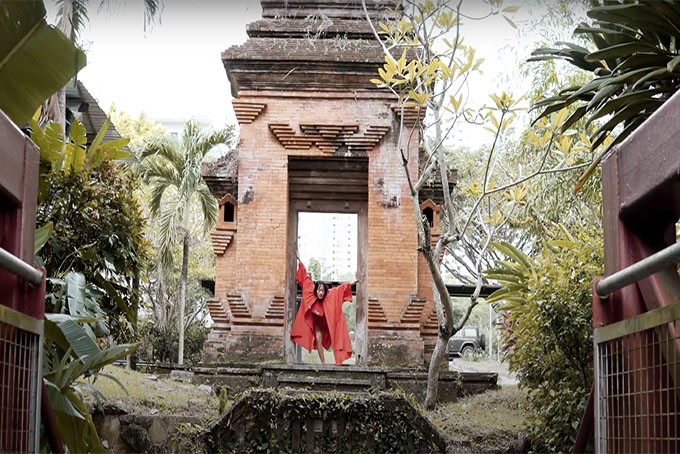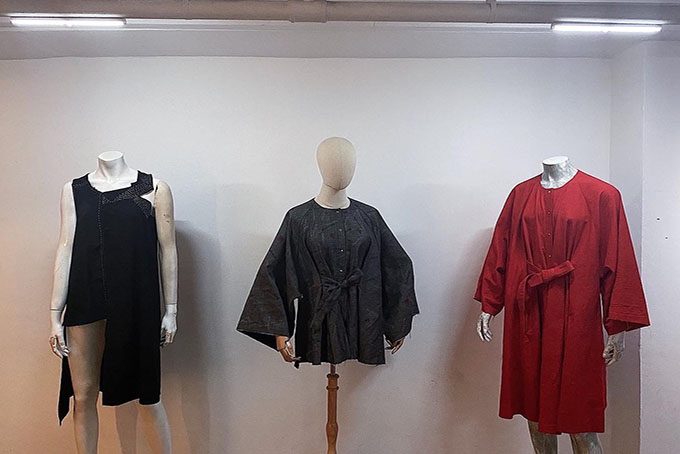In an age where the breakneck speed of fast fashion has reached its peak and distanced us from the origins of our clothing, pausing to reassess the value we assign to garments is ever-pressing. This much needed sensitivity to clothing’s significance is what fashion exhibition, The Soul of Things, gets to the heart of and excels at examining.
Currently running at Fashion On Display, an independent gallery nestled in the cobalt blue facades of Heng Loong Building, The Soul of Things focuses on the seventh collection of the same name by Singaporean fashion designer, Lilia Yip. On view are six garments selected from Lilia’s body of work that feature experimental pattern-cutting techniques and references to Eastern traditional garments from Japanese, Chinese, and Mongolian culture.

More significantly, the exhibition spotlights three Singapore-based fashion practitioners and their interdisciplinary reinterpretations of Lilia’s collection. This collaborative effort makes the third staging of The Soul of Things stand out from its earlier presentations in Hokkaido, Japan and Reykjavik, Iceland in 2018 and 2019, respectively. Visitors can look forward to seeing scholar-artist, Angelene Wong, dance in her film, ‘Plié’ and explore clothing’s semantic shifts as fabrics enfold the body’s exertion.
Another key highlight of the exhibit is imagemaker Jaya Khidir’s mesmerising film, ‘Id-entities’. Offering an intimate glimpse at how three young individuals style Lilia’s pieces, Jaya’s video navigates clothing’s relation to gender performance and self-expression. Photography enthusiasts can also look out for photographer Ethan Lai’s photo series, ‘Shell’. Distinct for its absence of a wearer, Ethan’s images dissect and reconstruct Lilia’s garments to unravel the beauty of pattern cutting.

With the intersection of fashion, music, and the visual arts happening at The Soul of Things, there are multiple avenues for visitors to engage with clothing. Expressing why the medium is so accessible in disseminating ideas, Lilia shares, “Whether or not you are trained in fashion, you wear and touch clothes. You can look at clothing in a deeper way or just visually appreciate them on the surface level. Some people come here and they want to talk about the concept. Some are more interested to know about sustainability. At the core of it, they all connect to clothing because it is coming from their body.”
Upon entry, expect to be greeted by well-dressed mannequins and the sound of Lilia’s whimsy: lo-fi music. In such a cosy environment that defies the conventions of white cube galleries, anyone can find a personal connection with clothes—for they are part of the very fabric of our being.
Here, Vogue Singapore speaks to curator, Weiqi Yap, and fashion designer, Lilia Yip, on what we can glean from the exhibition as it makes its first appearance in Singapore.
Weiqi Yap
An independent fashion writer, researcher, and curator, Weiqi Yap runs Fashion On Display, a Singapore-based independent fashion curation studio and experimental gallery dedicated to exhibiting fashion and everyday dress. Her writing seeks to unpack our intimate relationship with fashion, dress, and personal style.
How do the the works by Angelene Wong, Ethan Lai and Jaya Khidir expand on Lilia’s collection?
Each of our collaborators have located personal connections to the themes of magic, ritual and protection. Angelene’s three-part dance film took these words as framing devices for her choreography and situates these seemingly primordial ideas of ritual and magic in very urban spaces. Ethan’s photographs looked at Lilia’s garments as protective armour by suspending them and splaying them two-dimensionally, creating what resembles a very ritualistic display of animal skins and taxidermy.
Lastly, Jaya’s film combines the use of unsettling text, sound, and a documentary-style gaze to introduce the idea of self-fashioning to Lilia’s collection—which is arguably a form of ritual and protection. I think these three works managed to ignite fascinating connections between The Soul of Things and our local community of fashion practitioners.

The show recontextualises Lilia’s collection and brings together different generations of fashion practitioners in Singapore. Could you share how the exhibition explores the concept of time?
The idea that fashion moves forward and only in one direction is very much a Eurocentric concept. Much of the fashion industry as we know it functions in this way: fashion weeks, the need for new trends every season, the rate at which we produce and consume fashion. With Lilia’s practice, her collections stretch beyond a one-off seasonal debut—her rumination on the themes and ideas of a collection can span over a number of years. They evolve over time through the different iterations they go through.
The Beacon Coat that is on view, for example, has gone through three iterations since it was first made in 2018. A year later, the Chinese character ‘夢’ (meaning ‘dream’) was hand-printed on the lapels. Then in 2021, a digitally printed silk artwork was added as a lining. This adaptation and evolution of a garment over time resists convention and the assumption that clothes are only ‘relevant’ for a season or made for a singular moment in time.
“With Lilia’s practice, her collections stretch beyond a one-off seasonal debut—her rumination on the themes and ideas of a collection can span over a number of years.”
What do you hope audiences take away from the exhibition?
I hope that audiences are moved by the works in the show. Beyond the rigour of research and references that underpin the garments and each of the commissioned works, I think one of the most magical things about the exhibition is the way the space makes you feel. There is an emotional and spiritual dimension to The Soul of Things that I think could not have been planned or engineered. I hope people feel that just by being in proximity to these wonderful fashion works.

Lilia Yip
Lilia Yip is a fashion academic, designer, visual artist, and musician. A senior lecturer in Fashion Design and Development at the London College of Fashion, Lilia creates work that exists on the boundaries between our cultures, identities, histories and bodies; where the wearable, the surreal, the imaginative and mundane meet.
How did the artistic responses by Angelene, Jaya, and Ethan change your perspective of your collection and practice in fashion design?
At the heart of my practice is the mutual exchange of ideas, so it was wonderful to explore various aspects of my work with each artist. Angelene, Jaya, and Ethan have expanded my The Soul of Things universe and brought clarity and rich conversations to my practice that I would love to embed in future projects.

What made you gravitate towards independent exhibition spaces like Fashion On Display as opposed to commercial spaces?
I am drawn to independent spaces because of the flexibility and open nature in which they operate. They are intimate spaces that allow visitors to pause, reflect, and engage in conversation. Having said that, I am not opposed to showing in a museum and have done so in the past.
Fashion On Display is a perfect fit for The Soul of Things because its founder and curator, Weiqi Yap, brings an innovative, investigative, and critical eye to fashion curation that fully aligns with my values and practice. I could not have asked for a better collaborator and the new works and conversations our exhibition has generated is a testament to the power of an independent space.
In Angelene’s film a cluster of safety pins is often pinned to a garment. This is also part of your everyday style. Is there a significance behind this?
This is an interesting question and sharp observation. When I was around three years old in London, it was the tail end of the punk era. I remember the kind of shock and awe I felt when I saw a guy with safety pins in his ears. This image stayed with me and punk’s anarchic spirit and challenging of the status quo is very much part of my everyday being—the deconstruction of clothes, the way things fray, and distressed textures. There is this link between punk, the Japanese avant-garde, and wabi-sabi that I connect with and it is part of my rebellious spirit.

Could you tell us about a particular piece from your collection that is a highlight in the exhibition?
The Red Kotoba Coat is one of the highlights of the exhibition. It is the foundation on which all other collection pieces are built upon. The coat is made from 100 percent organically sourced cotton that has been chemically dyed in my studio. Seam lines are stitched to create slits that allow a back belt to pass through to the front and tie at the true waist. They introduce a gathered front fullness to the garment, often seen in Cristobal Balenciaga’s dresses from the 1960s. I have sold multiple copies of this coat as its cut makes it a size-inclusive piece, flattering a range of body shapes and sizes.
This garment also has such a strong visual resonance that all three artists have chosen to feature the coat in their works. In Japanese, kotoba means word or words, and kotodama means the soul of words. I like to think of the coat as a piece of embodied energy. This is what I understand to be the ‘magic’ or ‘power’ of clothing.
Fashion On Display, 61 Bukit Batok Crescent, 04-04D Singapore 658078.
The Soul of Things will run from 19 August to 3 September, 2022. Learn more here.





